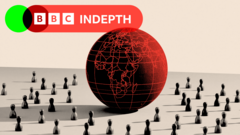Amid a flurry of complex global conflicts in 2024, the landscape of warfare has become more entangled than ever. The swift toppling of Syria's President Assad, the unexpected deployment of North Korean troops in Ukraine, and the active participation of various nations in ongoing hostilities from the Middle East to Africa paints a picture of a world where battle lines are increasingly blurred.
Ukraine and Russia's prolonged conflict, which intensified with Russia’s invasion in February 2022, has seen implications of a shifting global order, including North Korea's recent involvement as Moscow's ally. The influx of North Korean soldiers into the conflict raises the stakes for Ukraine, heightening fears and leading Western nations to reconsider their support strategy. Ukrainian forces are caught in an uphill battle as Russia's military support continues unabated from allies like Iran, which has provided critical drone technology.
In the Middle East, the landscape shifts dramatically with Israel's aggressive posture across multiple fronts. The untimely demise of Syria's long-standing president, Bashar al-Assad, has disrupted the regional balance, rendering Iran and its allied forces vulnerable amidst ongoing Israeli offensives. Failed attempts at ceasefire agreements in Gaza further complicate the situation, with massive civilian casualties and displacement resulting from Israel's ongoing campaign against Hamas.
As these conflicts evolve, Iran emerges as a pivotal player, having bolstered regional militias while simultaneously providing missile support to Russia. This partnership raises questions about what concessions or technological advancements North Korea may seek in return for its military assistance—an exchange that deepens existing tensions on the Korean Peninsula.
Conversely, conflicts extend into Africa, where the presence of Russian mercenaries signals Moscow's ambitions to expand its influence, despite significant losses in Syria due to the shifting power dynamics.
Anticipating the future, one must consider the ramifications of the geopolitical shifts illustrated throughout this tumultuous year. The prospect of renewed violence in the Middle East, unresolved issues in Ukraine, and potential flashpoints in East Asia loom as global stability remains in precarious balance.
As observers contemplate the international security landscape in 2024, it becomes clear that the conventional divisions of friendships and enmities have given way to a more chaotic panorama, challenging the global community's ability to promote peace and stability.
Ukraine and Russia's prolonged conflict, which intensified with Russia’s invasion in February 2022, has seen implications of a shifting global order, including North Korea's recent involvement as Moscow's ally. The influx of North Korean soldiers into the conflict raises the stakes for Ukraine, heightening fears and leading Western nations to reconsider their support strategy. Ukrainian forces are caught in an uphill battle as Russia's military support continues unabated from allies like Iran, which has provided critical drone technology.
In the Middle East, the landscape shifts dramatically with Israel's aggressive posture across multiple fronts. The untimely demise of Syria's long-standing president, Bashar al-Assad, has disrupted the regional balance, rendering Iran and its allied forces vulnerable amidst ongoing Israeli offensives. Failed attempts at ceasefire agreements in Gaza further complicate the situation, with massive civilian casualties and displacement resulting from Israel's ongoing campaign against Hamas.
As these conflicts evolve, Iran emerges as a pivotal player, having bolstered regional militias while simultaneously providing missile support to Russia. This partnership raises questions about what concessions or technological advancements North Korea may seek in return for its military assistance—an exchange that deepens existing tensions on the Korean Peninsula.
Conversely, conflicts extend into Africa, where the presence of Russian mercenaries signals Moscow's ambitions to expand its influence, despite significant losses in Syria due to the shifting power dynamics.
Anticipating the future, one must consider the ramifications of the geopolitical shifts illustrated throughout this tumultuous year. The prospect of renewed violence in the Middle East, unresolved issues in Ukraine, and potential flashpoints in East Asia loom as global stability remains in precarious balance.
As observers contemplate the international security landscape in 2024, it becomes clear that the conventional divisions of friendships and enmities have given way to a more chaotic panorama, challenging the global community's ability to promote peace and stability.


















